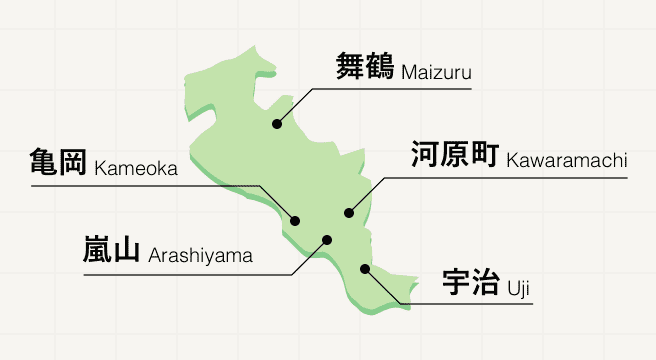Candy Store Spots in Around Ginkaku-Ji Temple Area
Area
-
-
Kyoto
-
-
Kyoto
-
-
Around Ginkaku-Ji Temple
-
- All areas
- Around Gion
- Around Kiyomizu-Dera Temple
- Around Okazaki
- Around Ginkaku-Ji Temple
- Ichijo-ji Temple / Shugakuin
- Around Fushimi Inari
- Around Kyoto Station
- City Center
- Around Kyoto Imperial Palace
- Around Nishijin
- Around Kamigamo
- Around Kinkaku-Ji Temple
- Uzumasa / Hanazono
- Arashiyama / Sagano / Takao
- Around Mt. Hiei
- Ohara / Kurama / Kifune
- Katsura / Nishiyama
- Yamashina / Daigo
- Around Fushimi
- Around Uji
- Joyo / Yawata
- Kyotanabe / Kizugawa
- Kameoka / Nantan
- Maizuru / Miyazu
-
Around Ginkaku-Ji Temple

Category


-
- Kanoshojuan tetugakunomichi kyotochashituto
-
4.521 Reviews
- Gourmet / Alcohol
- Kyoto Prefecture Kyoto City Sakyo Ward 2-1 Waka Oji
- "The Kyoto Tea House Building was built by Kano Shoujuan, a Japanese confectionery shop known for its famous confections such as ""Amo,"" along the ""Philosophical Road,"" named after the philosopher Kitaro Nishida, who strolled along the road to contemplate his philosophy. The teahouse can also be used as a restaurant and a sweet shop, selling Shoujuan's famous confections and seasonal Japanese sweets."
-
2019/7/26(金) わらび餅食べたくて行ったのですが、店が閉まっていました。今年の7月1日から哲学の道の店舗は春秋だけの営業になっていました。 とても静かで、お菓子も美味しくて好きな店だったので残念です。
-
- Warabian
-
4.03 Reviews
- Gourmet / Alcohol
- Kyoto Kyoutoshi Higashiyama-ku Sennyujigoyounotsujichou 20-2
- This is a Japanese sweets shop in a hidden-away machiya (old townhouse) located a two-minute walk from JR Keihan Tofukuji Station. The pure Japanese-style interior has a relaxing, subdued feel. The shop’s inner garden gets lit up by illuminations at night, and becomes a different kind of magical space by day. Their specialty is “Torori-Warabimochi” (bracken starch dumpling), made from bracken starch from Japan and brown sugar from Okinawa’s Iriomote Island which is kneaded thoroughly with famous Kyoto water. The resulting soft and stretchable dumpling offers a brand-new taste sensation. It is complemented with the refreshingly sweet sauce of Kagawa refined sugar and Tanba black soybean flour. This dumpling is also available as a takeout option.
-
昨年12月に南禅寺の方へ移転してます。 今回はお取り寄せで、とろ〜りわらび餅を頂きました。 他にはなかなか無い食感が良いですね。
-
- mitarashidango kotoko demachiyanagi Honten
-
4.513 Reviews
- Gourmet / Alcohol
- Kyoto Kyoutoshi Sakyou-ku Tanakashimoyanagichou 17
-
上次京都之旅從鞍馬回來市區之後,走在路上發現這間烤糰子,吃了之後驚為天人。這次回到京都就想再吃一次,所以便特地走訪了一趟。這次是內用,還點了冰紅茶和一杯熱茶,烤糰子一隻點經典醬油烤糰子,另一個點奶油烤糰子,兩隻都很好吃,配著茶慢慢享用,很是愉悅。
Kyoto Areas

Its wooden tea houses, shuffling geisha, and spiritual sights have seen Kyoto hailed as the heart of traditional Japan, a world apart from ultramodern Tokyo. Despite being the Japanese capital for over a century, Kyoto escaped destruction during World War II, leaving behind a fascinating history which can be felt at every turn, from the fully gold-plated Kinkakuji Temple down to traditional customs such as geisha performances and tea ceremonies, which are still practiced to this day.
Best of Kyoto
Search by Region
-
- Hokkaido / Tohoku
- Hokkaido
- Aomori
- Iwate
- Miyagi
- Akita
- Yamagata
- Fukushima
-
- Kanto
- Ibaraki
- Tochigi
- Gunma
- Saitama
- Chiba
- Tokyo
- Kanagawa
-
- Koshinetsu / Hokuriku
- Niigata
- Toyama
- Ishikawa
- Fukui
- Yamanashi
- Nagano
-
- Tokai
- Gifu
- Shizuoka
- Aichi
- Mie
-
- Kinki
- Shiga
- Kyoto
- Osaka
- Hyogo
- Nara
- Wakayama
-
- Chugoku
- Tottori
- Shimane
- Okayama
- Hiroshima
- Yamaguchi
-
- Shikoku
- Tokushima
- Kagawa
- Ehime
- Kochi
-
- Kyushu / Okinawa
- Fukuoka
- Saga
- Nagasaki
- Kumamoto
- Oita
- Miyazaki
- Kagoshima
- Okinawa















